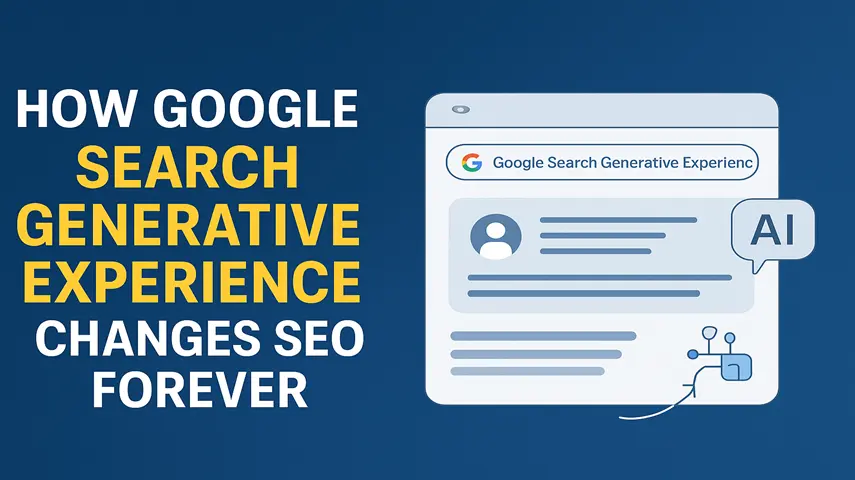Introduction: The Era of AI-Powered Search Begins
When Google introduced the Google Search Generative Experience (SGE), it marked the biggest shift in search behavior since the rise of featured snippets. By integrating generative AI directly into search results, Google has redefined how users interact with content and how brands must optimize it.
The Google SGE uses large language models (LLMs) to generate contextual answers to complex queries, reducing the need for users to click through to traditional websites. For digital marketers, SEOs, and web developers, this means one thing: SEO as we know it has changed forever.
In this guide, we’ll break down what SGE is, how it works, its impact on SEO strategies, and how you can adapt your site to stay visible in this new AI-driven search landscape.
1. What Is Google’s Search Generative Experience (SGE)?
Understanding SGE and How It Works
Google’s Search Generative Experience is an experimental version of Google Search that uses generative AI to provide synthesized answers at the top of search results. Instead of just showing a list of blue links, SGE generates an AI summary that blends insights from multiple sources.
For instance, when users search “best CRM software for small businesses”, SGE might show a paragraph summarizing key options, pros, and cons, followed by related links for deeper exploration.
SGE vs. Traditional Search Results
| Feature | Traditional SEO | Google SGE |
|---|---|---|
| Results format | 10 blue links | AI-generated summary with sources |
| Ranking basis | Keywords, backlinks, authority | Contextual understanding and semantic relevance |
| User intent handling | Limited | Predictive, conversational |
| Click-through patterns | High on top results | More engagement within the SGE summary |
Key takeaway: SGE prioritizes context over keywords, forcing SEO experts to rethink optimization for AI-driven search instead of traditional SERP ranking alone.
2. Why Google Introduced SGE: The Push Toward Generative AI Search
Google’s Response to AI Competitors
After OpenAI’s ChatGPT gained massive popularity, users began turning to conversational AI tools for information instead of search engines. Google’s SGE update is its strategic response — combining the reliability of Google Search with the intelligence of AI conversation.
According to Google’s official blog, SGE is designed to “make search smarter, faster, and more helpful” by reducing time spent comparing information manually.
The Shift in User Behavior
Modern users prefer quick, AI-generated answers over endless lists of web pages. This shift affects organic traffic patterns, users may get answers directly from SGE summaries instead of clicking your page.
For SEO professionals, this means content must now compete for inclusion in AI summaries, not just SERP rankings.
3. How Google SGE Changes SEO Forever
From Keyword Optimization to Contextual Authority
In the era of Search Generative Experience SEO, Google no longer focuses heavily on keyword repetition. Instead, it analyzes semantic depth, context, and factual reliability.
This means:
-
Pages that answer questions comprehensively are more likely to appear in SGE snippets.
-
Content with original insights or expert-driven commentary gains higher AI trust signals.
-
Structured data and schema markup become crucial for machine understanding.
New SGE Ranking Factors to Watch
| New SEO Factor | Description | Optimization Tip |
|---|---|---|
| Topical authority | Expertise across related subjects | Create interconnected topic clusters |
| Content depth | Comprehensive, factual coverage | Use supporting data and sources |
| E-A-T signals | Expertise, Authoritativeness, Trustworthiness | Show author credentials, cite sources |
| Semantic markup | Structured schema for clarity | Implement FAQ, HowTo, and Article schema |
4. SGE vs. Traditional SEO: What’s Different?
The Decline of Classic SERP Clicks
Traditional SEO revolved around ranking #1. But with Google search with AI, users may get what they need without ever clicking, especially for informational queries.
This doesn’t mean SEO is dead; it means visibility shifts from “ranking” to being referenced in AI summaries.
What Still Matters in the SGE Era
-
On-page SEO (titles, headings, meta descriptions) remains relevant.
-
Authority and trust (backlinks, reviews, authorship) still matter.
-
Multimedia-rich content (videos, visuals, data tables) improves engagement and AI summarization.
If your site already ranks well for featured snippets or People Also Ask sections, you’re well-positioned for SGE visibility.
5. Optimizing Your Content for the Google SGE Update
Step-by-Step: How to Make Your Site SGE-Ready
-
Focus on People-First Content
Write content that answers real user questions with value, not just keywords. -
Use Structured Data Markup
Add schema for articles, FAQs, reviews, and products, it helps AI understand context. -
Strengthen Your E-E-A-T Signals
Show author bios, professional credentials, and trustworthy references. -
Create Topic Clusters
Interlink related pages internally, e.g., from your SEO strategy guide to your content optimization tutorial. -
Add AI-friendly Content Formats
Use bullet lists, tables, and concise summaries, AI reads structured info more easily.
Technical SEO Still Matters
Even in AI-powered search, technical foundations like page speed, mobile responsiveness, and secure HTTPS remain critical. Google’s AI pulls from trustworthy, optimized sources, so slow or poorly structured websites may lose visibility.
6. The Impact of SGE on Different Types of Websites
For Blogs and Publishers
SGE may reduce clicks for generic informational queries. To counter this:
-
Create original research and insights that AI cannot replicate.
-
Publish long-form, evergreen content optimized for semantic depth.
For E-Commerce Websites
Product-related searches in SGE will show AI summaries including top-rated items with attributes, reviews, and pricing.
➡ Tip: Use rich snippets (Product schema) and customer reviews to boost your chances of inclusion.
For Affiliate Marketers
AI-generated summaries can reduce traffic from “best product” queries.
To adapt:
-
Focus on niche topics and expert reviews.
-
Create interactive content like comparison charts or calculators that AI snippets can’t fully replace.
💡 Internal link example: A Step-by-Step Guide: How to Choose Keywords for SEO.
7. Future Predictions: What Comes Next After SGE?
AI-Powered Personalization Will Grow
Google’s AI-powered search results will soon adapt to personal user behavior, search history, and location, creating unique SERPs for each person.
Voice Search and Conversational SEO
As SGE merges with voice assistants like Google Assistant, conversational SEO will dominate. Marketers must optimize for natural language queries, e.g., “What’s the best laptop under $1000 for students?”
Integration with Other AI Tools
Expect SGE to integrate with Google Workspace and Ads, allowing AI-driven ad targeting and smart content generation directly from search trends.
8. How to Stay Ahead in the SGE Era
Key Takeaways
-
Understand user intent deeply — AI rewards clarity and context.
-
Leverage structured data to make your content AI-readable.
-
Build authority through consistent, expert-driven content.
-
Experiment — monitor which content types appear in SGE answers.
-
Keep learning — AI search is evolving rapidly.
Conclusion: SEO Isn’t Dead — It’s Evolving
The Google Search Generative Experience (SGE) doesn’t kill SEO; it transforms it. Traditional ranking strategies now share the stage with AI-driven visibility, rewarding sites that prioritize user value, context, and credibility.
As Search Generative Experience (SGE) continues to evolve, SEO professionals, marketers, and web developers must stay agile. Strategies that once worked may need complete overhauls as Google continues refining how generative AI processes search queries.
👉 Ready to future-proof your SEO strategy?
Subscribe to our newsletter and let’s shape the AI-driven SEO future together.




